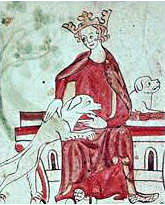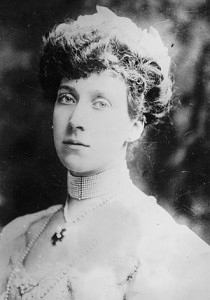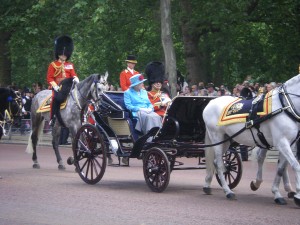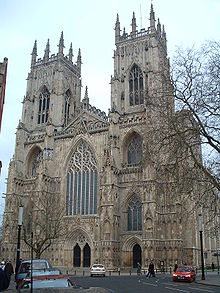Queen Elizabeth II, the Duke of Edinburgh and their granddaughter Princess Beatrice will attend the Royal Maundy Thursday service at York Minster this Easter. This service was traditionally an opportunity for the poor to receive alms in the sovereign’s name but the current Queen has transformed the event into an opportunity to personally honour seniors who have contributed to their community and church. 86 men and 86 women, one for each year of the Queen’s age will receive a commemorative Diamond Jubilee coin and specially minted Maundy coins as keepsakes of the event. The structure of the Maundy service, the decision to hold this ceremony in York Minster and the presence of members of the extended royal family are all significant to the history and future of the royal family.

A thirteenth century image of King John, who reigned from 1199 to 1216, with his hunting dogs. John is the first recorded monarch to provide alms for the poor on Maundy Thursday.
Through her active participation in Maundy services, the Queen has revived a ceremony that received little interest from the monarchy between the reign of Queen Anne and the reign of George V. While there are recorded instances of churchmen washing the feet of the poor and providing Maundy Thursday alms since the 5th century, the first monarch to be involved in this ceremony was the notorious King John. In 1212, John gave thirteen pence to thirteen poor men in Rochester Cathedral. The distribution of these alms may have been an attempt to improve his reputation with his subjects and the clergy. John had been excommunicated by Pope Innocent III in 1208 for seizing church lands, and was widely unpopular for raising crippling taxes to first pay his brother King Richard’s ransom at the end of the Third Crusade then to fight a expensive war with France to attempt to regain the Duchy of Normandy.
John’s son Henry III and all his children participated in several Maundy celebrations each year, emphasizing the piety and humility of the royal family. Edward I “Longshanks” established the custom of only holding Maundy services on the Thursday before Easter and subsequent monarchs and consorts held more and more elaborate ceremonies. Although Mary I was Roman Catholic and Elizabeth I was Supreme Governor of the Church of England, both sisters held elaborate Maundy services, washing the feet of the poor (after they had been pre-washed three times by court servants and officials) and distributing extensive alms. Mary followed the example of her mother, Catherine of Aragon and gave the poorest woman present her own gown. James II was last monarch to actually wash the feet of the poor and the alms giving became less widespread in the eighteenth century.

Princess Marie Louise of England, daughter of Prince Christian of Schleswig-Holstein and Princess Helena of the United Kingdom. Marie Louise attended Maundy Thursday services with her mother and suggested that George V participate in the almsgiving.
As discussed in Silver Pennies and Linen Towels: The Story of the Royal Maundy by Brian Robinson, royal participation in Maundy services ended in the eighteenth century with court officials providing the alms in the monarch’s name. Members of the extended royal family continued to attend the service, however, and in 1931, Princess Marie Louise suggested to her cousin, King George V that he might personally distribute the alms the following year. At that time, the recipients tended to be heads of households that had experienced unexpected financial difficulties. Elizabeth II eventually transformed the ceremony into a celebration of service to church and community.
York Minster cathedral has longstanding associations with the current British royal family. The second son of the monarch traditionally receives the title of “Duke of York” recalling the combined Lancaster and York descent of the Tudor dynasty, at the end of the Wars of the Roses in 1485. The Queen’s cousin, the Duke of Kent married Katherine Worlesley in York Minister in 1961 in the presence of the Queen, Prince Philip and Prince Charles. There had not been a wedding of a senior member of the royal family in York Minster since King Edward III married Princess Philippa of Hainault in 1328.
The attendance of Princess Beatrice at the 2012 Maundy Thursday service demonstrates her interest in carrying out royal duties. Queen Elizabeth II’s cousins, the Dukes of Kent and Gloucester and Princess Alexandra currently perform extensive royal duties but there is evidence that Prince Charles and Prince William intend to preside over a smaller group of active members of the royal family. Beatrice’s activities during the Diamond Jubilee celebrations may determine whether she spends her adult life as a working member of the royal family or if she persues an independent career as a private citizen.
The 2012 Maundy Thursday service at York Minster reflects Elizabeth II’s innovative approach to a centuries old royal tradition involving the sovereign and members of the royal extended family in the recognition of community service in York. The historic York Minster cathedral has long standing associations with the royal family and is the ideal setting for this ceremony.

